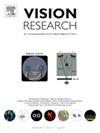S cone increments and decrements: Nearly-linear perceptual scales and variable noise
IF 1.4
4区 心理学
Q4 NEUROSCIENCES
引用次数: 0
Abstract
Two psychophysical experiments investigated perceptual differences between increases and decreases in stimulation of the short-wavelength (S) cone photoreceptors. In Experiment 1, observers’ suprathreshold perceptual scale responses to S cone stimulation were estimated using the Maximum Likelihood Difference Scaling (MLDS) procedure. In Experiment 2, observers’ pedestal discrimination thresholds were measured with a two alternative forced choice (2AFC) method. Both experiments were performed using incremental (S+) and decremental (S−) contrasts separately. Substantial asymmetry between S+ and S− was found in pedestal discrimination thresholds, but not in S+ and S− perceptual scales: perceived S cone contrast was nearly linear with S cone contrast for both polarities. To reconcile perceptual scales and thresholds, a model is proposed in which the noise in the S cone pathway is assumed to be proportional to the square root of stimulus contrast. The model works well for both the perceptual scales and forced-choice discrimination, indicating that S+ and S− signals are processed in an asymmetrical way, likely due to the physiological differences between S ON and S OFF pathways.
S锥增量和递减:近线性感知尺度和可变噪声
两个心理物理实验研究了短波锥光感受器刺激增加和减少之间的感知差异。实验1采用最大似然差标度法(MLDS)估计观赏者对S锥刺激的超阈知觉标度反应。实验2采用两种强迫选择法(two alternative forced choice, 2AFC)测量观察者的基座辨别阈值。两个实验分别使用增量(S+)和递减(S−)对比进行。S+和S -在基座辨别阈值上存在明显的不对称性,但在S+和S -知觉尺度上没有发现:在两个极性上,感知到的S锥对比与S锥对比几乎是线性的。为了协调感知尺度和阈值,提出了一种假设S锥通路中的噪声与刺激对比度的平方根成正比的模型。该模型适用于感知尺度和强迫选择辨别,表明S+和S -信号以不对称的方式处理,可能是由于S ON和S OFF通路之间的生理差异。
本文章由计算机程序翻译,如有差异,请以英文原文为准。
求助全文
约1分钟内获得全文
求助全文
来源期刊

Vision Research
医学-神经科学
CiteScore
3.70
自引率
16.70%
发文量
111
审稿时长
66 days
期刊介绍:
Vision Research is a journal devoted to the functional aspects of human, vertebrate and invertebrate vision and publishes experimental and observational studies, reviews, and theoretical and computational analyses. Vision Research also publishes clinical studies relevant to normal visual function and basic research relevant to visual dysfunction or its clinical investigation. Functional aspects of vision is interpreted broadly, ranging from molecular and cellular function to perception and behavior. Detailed descriptions are encouraged but enough introductory background should be included for non-specialists. Theoretical and computational papers should give a sense of order to the facts or point to new verifiable observations. Papers dealing with questions in the history of vision science should stress the development of ideas in the field.
 求助内容:
求助内容: 应助结果提醒方式:
应助结果提醒方式:


